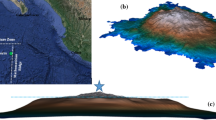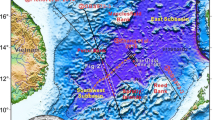Abstract
Analyses of the marine geophysical data collected in four oceanographic cruises during 1974–2008 inside the Gulf of Kachchh, northwest India was done, and geology and crustal structure were interpreted for the first time. Seabed topography deduced from satellite-derived bathymetry and bathymetric investigations has revealed the tide-dominated Gulf (> 6 m high) has ~50 m maximum depth along the axial part. The satellite-derived free-air gravity anomalies and their horizontal gradients together with earlier published results helped in noting major crust features like faults. Analyses of single and multi-channel seismic reflection data had enabled identifying reflection strata pattern and their continuity, wave-field and acoustic characters. 2-D model studies of ocean-bottom seismic refraction data (following ray-tracing technique), satellite-derived free-air gravity anomalies, magneto-telluric data along a profile in middle of the Gulf and magnetic anomalies near Gulf mouth have led to determine various physical properties: velocity, density, resistivity and the magnetic of the subsurface layers. They have been utilized in interpreting three-layered crust structure of the Gulf. Further, presence of ~3.0 km thick low, ~3.7 km/s velocity and 2.2 gm/cc density layer overlain by about 2.1 km thick high, 4.6 km/s velocity, and 2.55 gm/cc density layer noted. Considering the physical properties in correlation with mainland geology and crustal structure from onshore Suthri-1 and inner shelf GK-01-A1 well logs and coast parallel Mandvi–Mundra deep seismic study results, low and high-velocity layers have been noted as low velocity Mesozoic sedimentary rock formations overlain by high velocity Deccan volcanic rock formations. The volcanic rock thickness increases to the east are noted. The Tertiary sediments above them are ~1.2 km thick. The major crustal structures and geology identified contribute to understand regional geology, structure and tectonic framework of the Kachchh region and in particular, of the study area. The fractured Deccan volcanic rocks and their intervening intra-trappean sediments are possibly considered as potential hydrocarbon-bearing formations (?) in view of the underlying thick Mesozoic sediments.
Highlights
-
1.
Seismic reflection, OBS, and magneto-telluric data revealed three layered crustal structure of the Gulf
-
2.
We have identified fractured Deccan volcanic rocks and their intervening intra-trappeans sediments inside the Gulf
-
3.
Presence of low velocity Mesozoic sedimentary rock formations overlain by high velocity Deccan volcanic rock formations











Similar content being viewed by others
References
Andersen O B 2010 The DTU10 gravity field and mean sea surface; Second international symposium of the gravity field of the Earth (IGFS2), Fairbanks, Alaska.
Biswas S K and Deshpande S V 1973 A note on the mode of eruption of Deccan Trap lavas with special reference to Kutch; J. Geol. Soc. India 14(2) 134–141.
Biswas S K 1982 Rift basins in western margin of India and their hydrocarbon prospects with special reference to Kutch basin; Am. Assoc. Pet. Geol. Bull 66 1497–1513.
Biswas S K 2005 Tectonic style and sediment dynamics of rifted basins, their bearing on Petroleum habitat – Examples from Satpura and Kutch basins, India; Indian J. Petrol. Geol. 14(1) 1–29.
Chamyal L S, Maurya D M and Raj R 2003 Fluvial systems of the dry lands of western India: A synthesis of Late Quaternary environmental and tectonic changes; Quat. Int. 104 69–86.
DGH report 2008 Marine seismic and marine magnetotellurics in the Gulf of Kutch region, Gujarat, India, No. NGRI-2008-exp-656, 399p.
Glennie K W and Evans G 1976 A reconnaissance of the Recent sediments of the Ranns of Kutch, India; Sedimentology 23(5) 625–647.
Gopala Rao D, Bhattacharya G C and Krishna Rao K S V R 1977 Magnetic anomalies at the mouth of the Gulf of Kutch; Indian J. Mar. Sci. 7 120–122.
Gopala Rao D 1988 A shallow seismic reflection study of the Gulf of Kutch, northwest India-Observations on its structural evolution; Mar. Geol. 82 277–283.
Koulomzine Th, Lamontagne Y and Nadeau A 1970 New methods for the direct interpretation of magnetic anomalies caused by inclined dikes of infinite length; Geophys. 35 812–830.
Krishna J, Pathak D B, Pandey B and Ojha J R 2000 Transgressive sediment intervals in the Late Jurassic of Kachchh, India; Geo-Research Forum 6 321–332.
Krishnan M S 1982 Geology of India and Burma; 6th edn, Delhi, CBS Publishers.
Laju M, Gopala Rao D, Krishna K S and Vora K H 2009 Late Quaternary seismic sequence stratigraphy of the Gulf of Kachchh, northwest of India; J. Coast. Res. 25(2) 459–468.
Pandey D K, Rajan S and Pandey A 2010 Seismic imaging of Paleogene sediments of Kachchh Shelf (western Indian margin) and their correlation with sea-level fluctuations; Mar. Petrol. Geol. 27 1166–1174.
Rajendra Prasad B, Venkateswarlu N, Prasad A S S S R S, Murthy A S N and Sateesh T 2010 Basement configuration of on-land Kutch basin from seismic refraction studies and modeling of first arrival travel time skips; J. Asian Earth Sci. 39 460–469.
Ravindran C N, Kundu R N, Dasgupta A, Ramah M, Bhatia B, Nalini R, Mishra C S and Mehrotra K L 2012 Cretaceous sedimentation history and hydrocarbon potential of Kutch offshore; ONGC Bull. 47(1) 16–26.
Rodi W L and Mackie R L 2001 Nonlinear conjugate gradients algorithm for 2-D magnetotelluric inversion; Geophysics 66 174–187.
Roy A B, Chatterjee A and Chauhan N K 2017 Geological evolution of Kachchh: An epitome of successive Phanerozoic events; Curr. Sci. 112(5) 1051–1056.
Sastry R S, Nagarajan N and Sarma S V S 2008 Electrical imaging of deep crustal features of Kutch, Western India; Geophys. J. Int. 172 934–944.
Ses G, Bizmis M, Das R, Paul D K, Ray A and Biswas S 2009 Deccan Plume, lithosphere rifting, and volcanism in Kutch, India; Earth Planet. Sci. Lett. 277(1–2) 101–111.
Srivastava P K 1965 A note on the Quaternary geology of Saurashtra peninsula; Quat. J. Geol. Minerol. Metallur. Soc. India 1 55–63.
Zelt C R and Smith R B 1992 Seismic traveltime inversion for 2-D crustal velocity structure; Geophys. J. Int. 108 16–34.
Zutshi P L, Jain M M and Srivastava H C 1989 Basement configuration of Kutch and Saurashtra basins; ONGC Bull. 26 53-62.
Acknowledgements
We thank Secretary, DST, New Delhi for funding project no. ESS/16/313/2006 to study the Gulf of Kachchh. We would also like to thank the Director General, Hydrocarbons and Director General, CSIR, New Delhi for funding the marine seismic and marine magneto-tellurics project as R&D project. We equally thank the Director, CSIR-NGRI for continuously supporting the projects and Director General, ISR, Ahmedabad, Gujarat. The marine magneto-telluric data has been acquired by Scripps Institute of Oceanography (SIO) under the contract between CSIR-NGRI and SIO and the team was headed by Prof Steve Constable. We gratefully acknowledge the entire SIO team.
Author information
Authors and Affiliations
Contributions
D Gopala Rao and K S Krishna conceived the ideas and experimental design of the study. DGR has carried out conceptualization, planning, execution and wrote the manuscript. M Ismaiel has carried out literature review and preparation of the figures. KSK and MI have carried out the revision. Most authors have participated in compilation of different experiments in Gulf of Kachchh, data analysis and interpretation. And subsequently authors have provided valuable suggestions for improvement of the work.
Corresponding author
Additional information
Communicated by N V Chalapathi Rao
** Passed away after the completion of this work.
Rights and permissions
About this article
Cite this article
Gopala Rao, D., Krishna, K.S., Harinarayana, T. et al. Crustal structure of the Gulf of Kachchh, northwest India. J Earth Syst Sci 130, 136 (2021). https://doi.org/10.1007/s12040-021-01623-0
Received:
Revised:
Accepted:
Published:
DOI: https://doi.org/10.1007/s12040-021-01623-0




